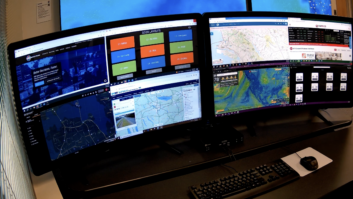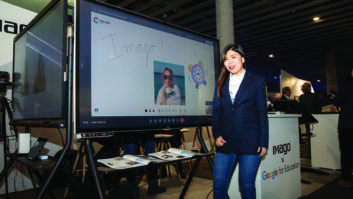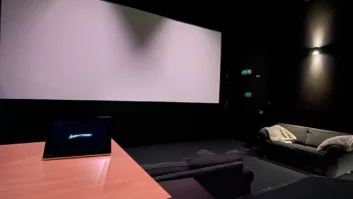Pairing good policies with technologies like calendar software and digital room signs can streamline room scheduling to make everyone’s life easier. Instead of putting up paper schedules, or managing reservations in multiple places, consider a comprehensive strategy.
1. Use a calendar app
It doesn’t make sense to have your team spend their valuable time manually handling room reservations, updates and cancellations. Calendar apps like Microsoft Exchange and Google Calendar let everyone in your organization see availability and book rooms in the software with just a few clicks. There are also apps that are tailored to different organizations like schools, hotels and conference centers that include features specific to those types of venues, and can even integrate with other software you’re using for facility management.
2. Publish your policies
Make your event organizers as self-sufficient as possible with some basic guidelines. Booking space should seem like a no-brainer, but everyone has different workflows and writing styles. People can only know what you want from them if you publish your policies somewhere accessible like your intranet. Make sure people know to cancel meetings in the app if they aren’t happening – especially things scheduled repetitively, like every week, or far in advance. Also, make sure they aren’t using your largest meeting space for a two-person chat when smaller rooms are available.
3. Set naming conventions
The most important policy you can put in place is how to name room bookings. Ask people to always use event names that are descriptive but concise. “Department meeting” leaves the reader asking which department, while “Acme bi-weekly marketing staff meeting” is too long. “Marketing staff meeting” gives all the information you need in a digestible chunk. Since people are used to character counts on social media and other platforms, putting together some basic limits should go over well.
4. Advertise room assets
Provide a photo of each room, along with details like seating capacity, furniture and audiovisual tools, so people can choose the best space for their needs. Some systems will let you do this within the scheduling app, but you can also publish this your intranet or in your policies. If you have an activity-based workplace that offers hot desking or office hoteling, be sure to show which areas are workspaces, call cubbies, huddle spaces or quiet zones for privacy.
5. Show schedules on digital signs
Nothing is more frustrating for your employees and visitors than arriving just prior to a meeting and being unable to find it due to lack of adequate directions. Use digital signs at entryways and in lobbies to show your event schedules with room names and start times to improve the attendee experience. You can also use your screens to show guest welcomes, speaker bios and other meeting-related content. It all adds up to ease stress and present a more positive shared experience.
6. Install room signs
If you’re looking for your meeting, or looking for a place to meet, digital room signs can help. These small screens outside your shared spaces can display that room’s schedule for the day, so people know they’re in the right place at the right time. Almost all digital room signs interface with your calendar app to pull schedules from a central source, and some allow you to book rooms right at the sign. Newer E Ink signs are wireless, lightweight and affordable, so they’re a great option for hoteling spaces. Just make sure that whatever room sign you choose can easily integrate with your calendar app, and that it has architectural accessories like mounts and mounting templates.
7. Use availability lights
If you are shopping for digital room signs, make sure you get a model that has availability lights built in. This is a simple on-screen or external indicator that shows if a room is busy or open. This is a great tool for large meeting areas or conference centers with multiple rooms. That way, if someone is looking for an open room to use at the last minute, they can simply glance down the hall to see if any of the lights are green. If your room signs let them book at the screen, they can grab the room right there and then.
8. Show message playlists
If you have a digital signage system, why not combine it with your room signs? If you can push your message playlists to room signs from a central source, it’s an easy way to keep people informed who might be tied up in meeting areas all day. That way, when they take a break, they can see all of your important announcements, so they don’t miss out. In many cases, you can also use an emergency override to push alerts to room signs, in case of severe weather or threats. If you can’t put your digital signage playlists to your room signs, you might be able to show basic images, like PowerPoint slides or JPGs, to accomplish the same thing.
9. Show cancellations
As we mentioned above, you’ll want people to cancel meetings in your app if they have plenty of notice. That way, all attendees can be notified, and the meeting wiped off their schedules. But if a meeting cancels at the last minute, consider modifying the name instead (e.g., “CPR Training – CANCELLED”). This can be a good way to get the attention of attendees who may not have checked their email before showing up to the room. The best practice is to show any cancellations that occur the same day as the meeting.
10. Send reminders
Everyone is busy and may not have tomorrow’s schedule memorised. Setting up email or calendar reminders for events can help keep both organisers and attendees on track. Be sure to include all of the same meeting information in the reminder as the original invitation, especially if it’s been over a week since the invite went out. Location and start time details help everyone to be on time, and an agenda lets people know what to expect and how to prepare for any topics they may need to cover. Also, someone might have a double-booking or last-minute project, and realise they need to reschedule once they get the reminder.
Author Bio:
Debbie DeWitt is the marketing communications manager for at digital signage solutions and interactive wayfinding provider, Visix, Inc.
www.visix.com.







